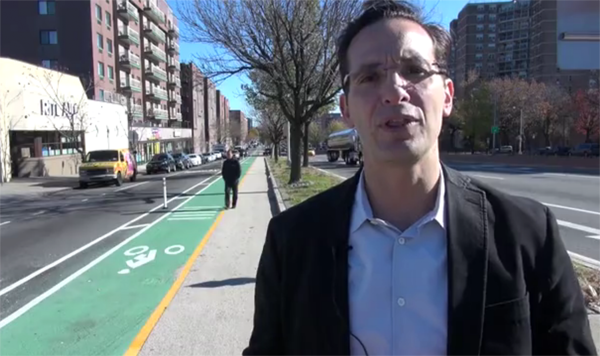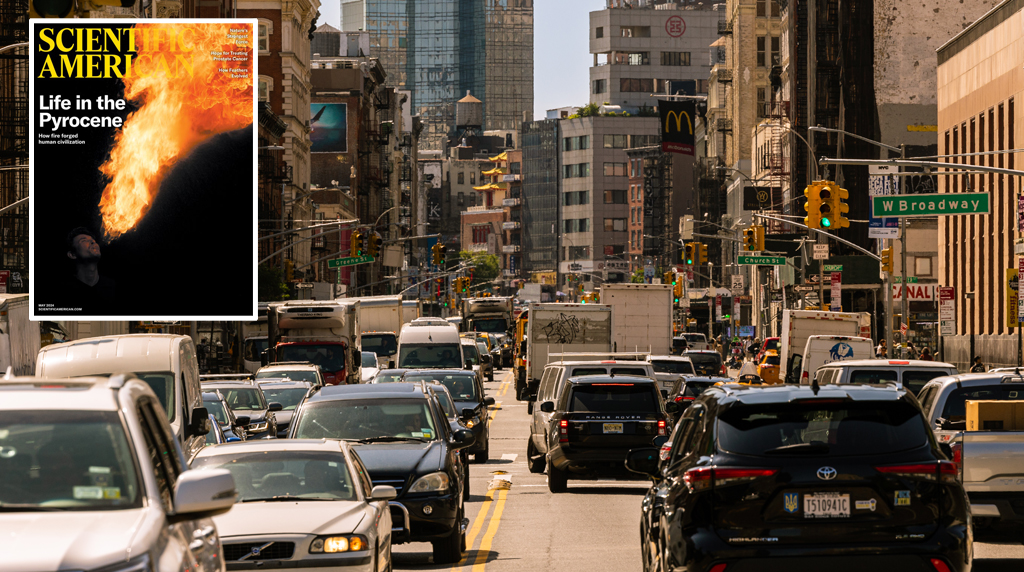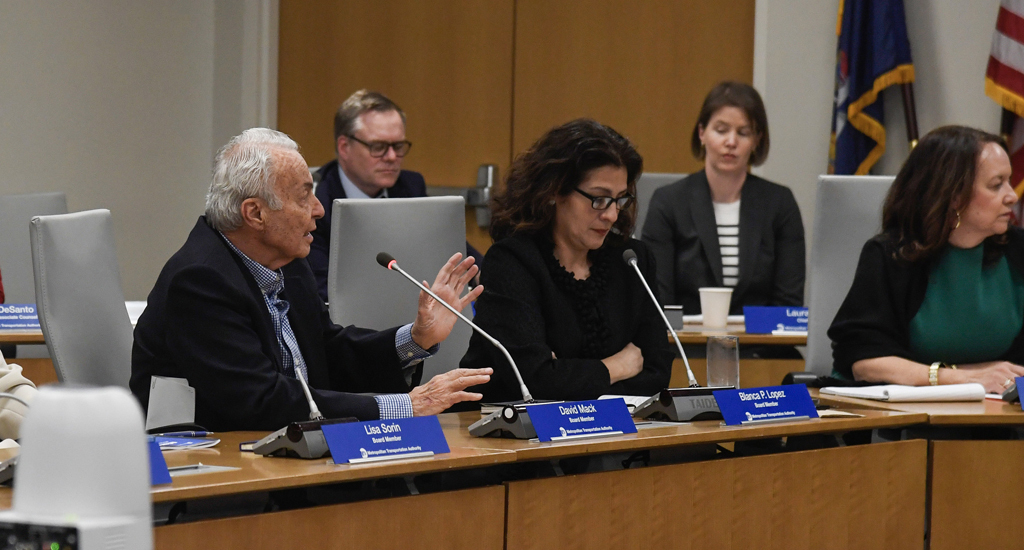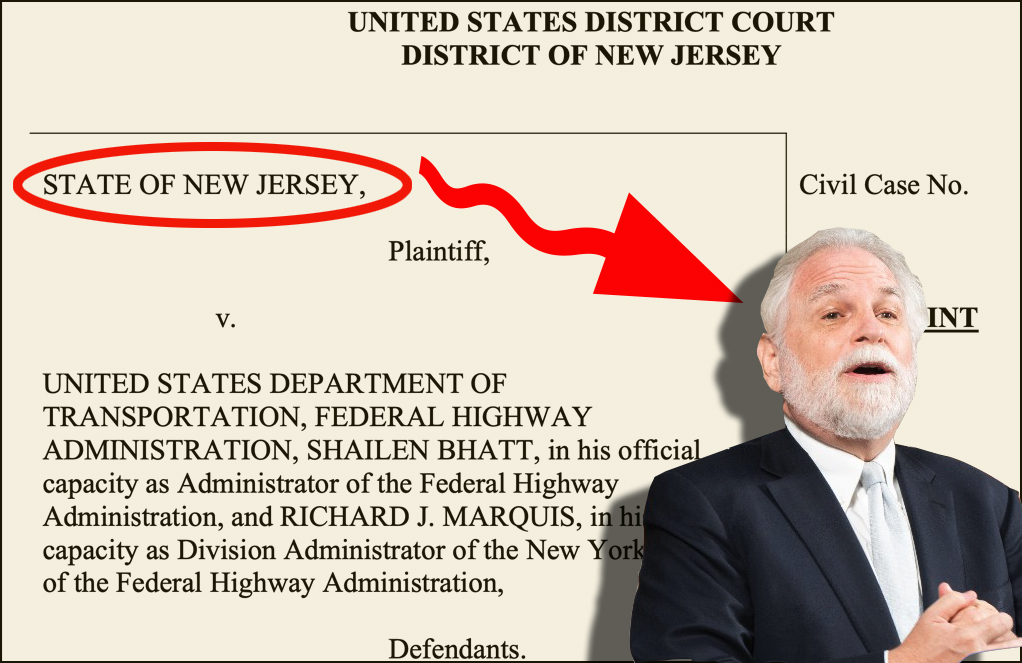Ryan Russo on NYC’s Bike Network Progress, Community Boards, and the Evolution of DOT
3:36 PM EDT on May 9, 2017

Ryan Russo walks through the redesign of Queens Boulevard for Streetfilms.
Yesterday we ran the first part of our interview with Ryan Russo, who wrapped up a 14-year tenure at NYC DOT in March before starting this week as the first permanent director of Oakland DOT. In New York, Russo led key programs under three transportation commissioners, and in part one he shared his perspective on the period of innovation for NYC streets and transportation policy that accompanied the rollout of PlaNYC.
Part two brings us to the present day. We discuss the state of bike network development, the potential introduction of different types of safety improvements to NYC streets, and how the public process for street redesign projects might be improved.
Please note that Russo was no longer working at NYC DOT at the time of our conversation and was not speaking in an official capacity on behalf of the department. The interview has been edited for length and clarity.
We've made so much progress on bike network development and what started out in 2007 as this stub on Ninth Avenue that was, what, like 10 blocks long?
Seven. 16th to 23rd.
Now you can see these real, continuous routes taking shape, but they're not all the way there. On First Avenue and Second Avenue, for instance, it's taking a long time. Seven years ago, I think, we first saw the plan for those streets. Can we be doing this faster in New York -- does it have to be as incremental as it's been?
Are you referring to the Second Avenue Subway section?
The subway was something that you couldn't get around, but the Midtown section, the sections around the bridge and the tunnel. Those are obviously difficult, engineering-wise, and I'm not saying it's easy. It just seems like the full benefit of having some continuity there would be really big for the bike network.
I think it's certainly, clearly beneficial, but inherently, by definition, it's going to be incremental. We talked about the operational toolkit. I think these projects tend to pop up, and people see a couple community meetings, and then they see the trucks out there striping this, but that's the tip of the iceberg in terms of what it takes to execute them. There's a lot of work that goes into it.
Those are two streets, but they run from Houston Street to 125th Street. That's seven miles each. Again, the outreach to local businesses, and tailoring the curb regulations, and all those things -- the traffic analysis, the design, the coordination with partners like the NYPD, the Fire Department, local electeds -- you want to get them right, so that they work.
We then do a study and say, "Injuries went down 20 percent or 30 percent, and cycling went up," and all those things that get used to say, "Hey, DOT, this stuff's great!" It's great because we did all of that groundwork to design it well.
I get that it can be frustrating that everything doesn't happen at once, but I do think things have accelerated, and what's been amazing, having a bit of the long view, is seeing the growing acceptance of these things in the public as a whole, so that the conversation isn't as complicated and drawn out. That has allowed a continued higher productivity.
The [DOT] team is balancing a really intense work program -- you get your eight months, if you're lucky, of good weather to be doing this [construction] work -- and the coordination of the crews. So there's all the pre-work that goes in, and then we don't pass off these projects. Those same people have to stick with it through implementation, which actually makes the projects go really well, but it becomes a pretty intense coordination and execution element. We have planners that have become construction project managers.
If there was a more explicit and stronger political commitment to doing these things faster, though, do you think more stuff could be getting through the pipeline, as difficult as it is?
It's a good question, because every year we think about, “What were the barriers? What was the constraining factor on us?”
What has been amazing about the team at DOT is that one year it might be signal construction capacity, and another one it's concrete. Another one, it's striping, another one, it's outreach and approval in the planning process, and can we make that smarter? People were always looking for the ceiling on the critical path. That strategic thinking has allowed us to ramp it up. What this year's ceiling will be, I don't know. But the thing that's really clear is that a lot of work is getting done. People are firing on all cylinders, and they're working extremely hard. They’re incredibly committed and dedicated.
People think it's, "Oh, you just throw money at it." If it's funded more or something, or it's politically accepted, it doesn't mean it would be easy to pull off, to grow. You can't clone a manager who knows these things and the people running the teams and divisions that have to coordinate all of this. That might be the critical path at this point. It could be a management thing, not just, "How much money do you have for stripes?"
One recent development that I think a lot of people are excited about is the possibility of protected bike lanes on Fourth Avenue in Brooklyn. DOT is showing some flexibility in adjusting the capital project mid-process.
I have to give Commissioner Trottenberg a ton of credit for pushing us to make sure we get it right, and to think it through, and to say, "Is there a way to do this? Can you really dig in and think hard about this?”
If you lived with Fourth Avenue before we did the road diet [in 2012 and 2013], it was impossible to imagine a bike facility on that street. The stakeholders couldn't imagine it. We made an incremental step, and cycling grew, and the street really improved, and this became a potential thing to put on the table. It was hard for a lot of folks internally [at DOT] to see that potential for evolution for the next step. DOT has to have a good conversation with the community and the stakeholders about this option, but I think it's very promising.

Let’s go through some things advocates have been asking for, like the protected intersection. Is that a design that has a place on New York City streets? Could it work here?
Yes. The Massachusetts state DOT design guide is a good reference about the principles of that treatment -- basically, Dutch intersection design. Just like we thought 10 years ago with Ninth Avenue, the conflict at the intersection is the thing that's most important to manage. The idea is that if you have a slow-turning vehicle with a good field of visibility, that you could get good yielding to bikes, and that the bikes could have a stronger feeling of safety and good lines of sight.
I think it's totally in the realm of possibility. I'm very proud of the innovations we've brought, that New York City DOT brought to bicycle facility design, intersection design, and I think the team will keep innovating.
What about the bike boulevard treatment? Are there parts of the city, maybe not in the central city but more residential parts, where this traffic filtering and traffic calming combination could make sense?
One of the joys of the work, and one of the challenges, is to understand the local context of the place you're working in. There's so many [different contexts] in New York, and New York has its own context. It's not just a simple matter of, you go to grad school and get the slideshow of these European tools, and say, "Why doesn't that happen here, here, and here? Can't it just happen? Why can't it just happen?” You have to really get the local context and apply it, and New York-ify the work.
Anything is possible in the right context, and I think the plan for the neighborhood traffic circles is the right plan for Greeley Avenue in Staten Island. That's an exciting new tool that has existed in other places.
When I say the local context, it's traffic volumes and circulation patterns, but it's also cultural and political. We're not just in a room saying, "Let's do this." It's about a conversation. The downtown Brooklyn traffic calming plan from 2001, the consultants proposed an option of diagonal diverters on Dean and Bergen Street. The local community, they see their local grid as something that gives them value, and gives them access, and there's a sacrifice for access.
I did my graduate studies at UC Berkeley, under professors who studied Berkeley's elimination of the grid for these kinds of treatments on residential streets, and one of the studies found that property values went up where everything was disconnected and went down on the streets that had to take the traffic on. The other streets that kept the traffic or had to absorb the traffic suffer.
It hasn't been something that has found the right place, or the right time, or the right community. I wouldn't rule it out. I don't think there's anything saying we couldn't do that. I haven't heard it called for loudly by either advocates or local communities, but it would be, certainly, something we're obviously aware of, and we'd do in the right context.
Another thing is dedicated signal phases. Do you think there's a case to be made for more dedicated pedestrian signal time?
It's, again, contextual. The split-phase [signals] or the flashing yellow arrow -- “split LPI” as we call it -- they require thoughtful study, and they're mini-projects. You need a turn lane, which has a parking implication, that you have to study and design, and then you have signal infrastructure that you have to put in. You have to decide the timing of those things.
To do them right, to have them actually work, it's not as simple as choosing something. You want certain conditions, a certain amount of turning conflict, a certain amount of pedestrian volume. So I think we've seen them growing in Manhattan, and I think Manhattan is a really good context for that, and then the context where we've been putting lots of leading pedestrian intervals are the arterial roadways that are more in the four outer boroughs. So, Northern Boulevard, where the cross-street volume is relatively low. There's just a need to give a pedestrian crossing that bigger arterial a head start. Our data and observations [show] that's very, very effective.
You're someone who's been working with the community board format for a really long time. If there's something you could change about the public process for street re-designs in New York City, what would it be?
Before I give my ideas, or suggestions, I would just point out that we have a really low pushback rate on the projects right now. The ones that stumble are the exceptions rather than the rules. I think that's good. Before you blow something up or change things, you need to take a step back and be like, "How well is it really going?" That's sort of the first thing.
As someone who likes getting things done, it can be tempting to, you know, relive the Robert Moses era, draw lines on a map and say, "This is what we want to do." But ultimately, I think that would be counterproductive, and we would end up with worse projects, and end up in a bad place. The community engagement, I think everyone agrees, is a really valuable thing, and our bigger projects really benefit when we get good input. That helps us tailor it.
We have to be cognizant that, in New York, it's a city of 8.5 million people. We work on a street for six months or a year, and then we move on to the next one. People have to live with it every day, who are there on that street.
That's the preface. In terms of how it could improve, I'd say the first thing is that it would be great if the forums were more uniformly open. When we have the dialogue with the community board, what can be frustrating is when there's an attempt to limit the conversation in a small venue, not publicly noticed, controlling where the conversation goes.
The City Council's been doing things around streaming some of these meetings, making sure they're publicly noticed, that people can participate. More participation, not less, would probably be a better outcome.
Second thing, is that for land use review, there is sort of a clock on ULURP. The notion of the clock that they put on that process is something to think about.
We need to value that there's diverse opinions out there, and people can have policy positions and perspectives that are different. We should get those out there, but there shouldn't be strategic [attempts] to game the process.
[Editor's note: For an example of how project opponents use delay strategies to stall the community board process, witness the calls for endless traffic studies of the 111th Street redesign in Corona.]
As someone who's been in the thick of it, how has the political attitude toward street transformation changed from 2003 to 2017?
It's 180 degrees for a large chunk of the city. Certainly, we were often on the defensive with the City Council. At budget time, the questions were, "How much money are you spending, and is this where we should find cuts to balance the budget?" The more recent conversation is, "How much money are you spending, and if there's more money, can you do more?" That's emblematic.
There were proposed policies and laws passed to hamstring or maybe slow the process, in that dialogue with the City Council years ago, and that's not happening now. The process of putting things on the street, actually seeing them work, has changed a lot. Clearly the advocates have done a tremendous job in promoting the benefits of these things, and that's been reflected in the leadership in what we hear from City Council. It's so different.
From the outside, DOT output has changed a lot in the last 14-15 years. Can you share with us the perspective from inside -- how the agency culture has changed in that time?
First, there's something that didn't change, which is the core values of safety and service, and the real dedication and commitment that exists in the agency. That's persistent, and something I learned and has really been great.
From a policy perspective, clearly, it's been a 180 degree turn, and I think there's real belief throughout the agency that the emphasis on high performance and high efficiency modes, that keeping people safe, speeding up buses, that sort of thing, I think is really embedded throughout the department in a way that it wasn't, and I think that's a really good thing.
If a cars-first commissioner were appointed, the analogy is like if you have a climate denier running the EPA. That's how it would feel to staff. It's really great, people working together, and I think there's, throughout the department, belief that where we're going right now is the right thing to do for the city.
Is there a broader shift in the profession, as new people become transportation engineers?
Definitely yes is sort of the short answer to that. Just a lot of people have come in. There's always been, like I said, a real commitment to safety, but there's been a lot of excitement about the approach, the multi-modal approach and perspective.
Clearly the leadership and policymaking that comes from above is important, but there's real buy-in that we can get the most out of our limited right-of-way with this approach. And there's just been so many tremendous people that have come into the agency as it's grown -- planners, engineers, policy people -- so it's in a good place.
Stay in touch
Sign up for our free newsletter
More from Streetsblog New York City
Deal Reached: Hochul Says ‘Sammy’s Law’ Will Pass
The bill, though imperfect, has been four years in the making.
Komanoff: A ‘Noise Tax’ Can Ground NYC Helicopters
A proposed $400 “noise tax” on “nonessential” flights is a start — and it will work.
Thursday’s Headlines: Welcome to the War on Cars, Scientific American
Our favorite story yesterday was this editorial in an unexpected place. Plus other news.
Meet the MTA Board Member and Congestion Pricing Foe Who Uses Bridges and Tunnels For Free Every Day
Mack drives over the transportation authority's bridges and tunnels thanks to a rare perk of which he is the primary beneficent.
Randy Mastro Aspires to Join Mayor’s Inner Circle of Congestion Pricing Foes
The mayor's reported pick to run the city Law Department is former deputy mayor under Rudy Giuliani and notorious foe of bike lanes and congestion pricing.




